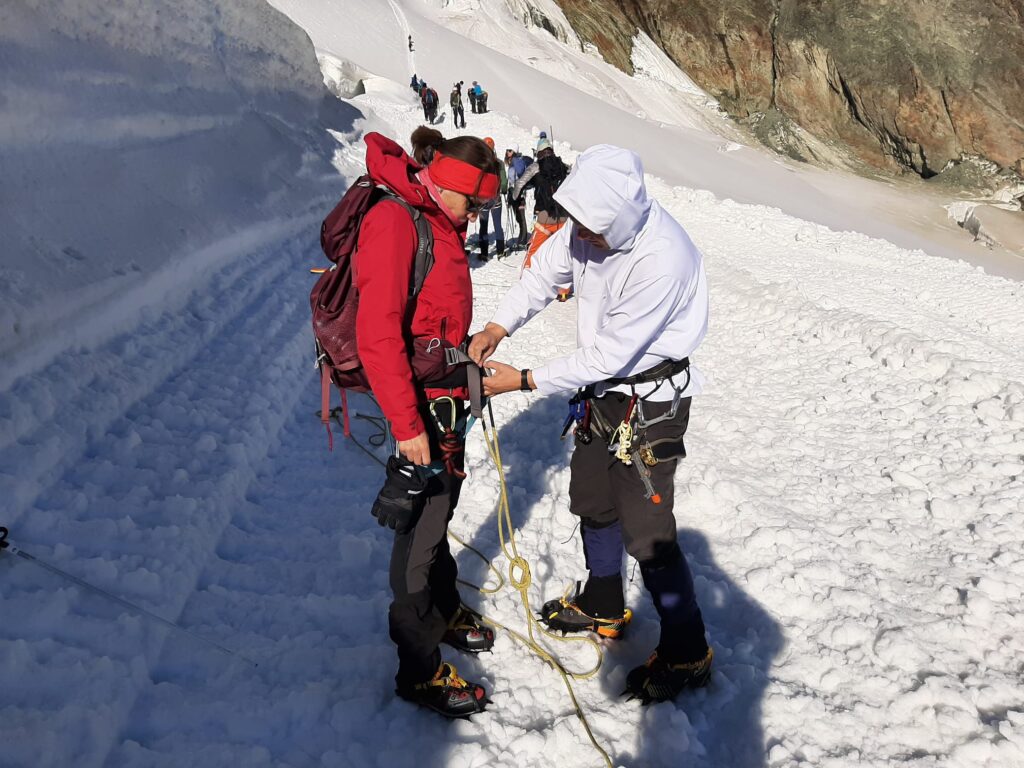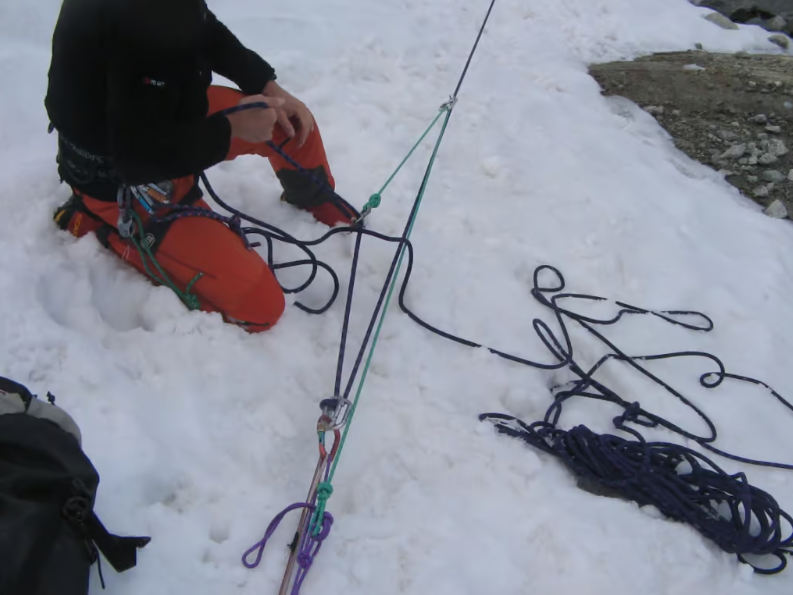My First Tour with a Guide – The Shock of My Life
August 2000
I had almost no mountaineering experience.
What’s a mountain school? Nonsense, I don’t need that.
What’s a mountain guide? A lazy guy who doesn’t want to get a real job. A guide is only for fools who can’t find the trail on their own.
September 2000
I joined the Swiss Alpine Club and set off on my first glacier tour: Bächistock, 2,914 m. In my backpack, I carried the cardboard box with my brand-new crampons! Everything was new: planning the tour, seeing a rope for the first time, carabiners… The group was very organized and moved very fast. I was exhausted and extremely frustrated that I didn’t understand all those knots, why we were roped up, and why we were already back at the hut by 2 PM.
Why did we leave the hut at 5 AM if it wouldn’t get dark until 9 PM?
Suddenly, I became extremely curious and realized that there was only one fool in the group—me.
Starting in 2001, I attended countless ice and rock climbing courses organized by the Swiss Alpine Club. By 2008-2012, I had become well-known in my SAC section: “That crazy guy who signs up for every tour in advance, fearing he won’t get a spot.”
My living room and garden were always filled with ropes, gear, practice setups… Stacks of mountaineering manuals… That was all I knew. During courses, I exhausted the instructors with endless questions.
Eventually, I started doing more technical tours alone or with friends, without the Alpine Club. I had mastered the techniques, practiced constantly, kept studying, and spent every weekend in the mountains, staying in countless huts. In my mind at the time, I was almost at a guide’s level when it came to glacier techniques.
Between 2015-2018, I slowed down on the tours.
Summer 2020
A conversation with Heidi, a coworker who always hikes with a guide and is the complete opposite of me – she doesn’t care about technique, just reaching the summit.
– Want to join me on a tour? I’m short on money, and we could split the cost of the guide.
– You know I’ve never gone with a guide and never will. If a peak is beyond my level, I won’t go—I’m not paying a guide. Not interested.
– Come on… Have you been to Weissmies (4,013m) and Lagginhorn (4,010m)?
– Weissmies? Oh, come on… It’s beneath me to pay a guide for those two peaks, where hundreds go each year without one.
– But not the normal route, Markus is thinking of traversing Weissmies.
– OK… fine, I’ll go…
I agreed just to make her happy, but I wasn’t thrilled about paying for a guide, especially for these peaks.
Markus, her neighbor, had been a guide for 20 years and made a living solely from guiding. Before him, she had only hiked with Noppa, a well-known Swiss guide who tragically died on Piz Bernina. He had climbed all the 8,000-meter peaks except Everest but slipped and hit his head at home in the Bernina range. It was a national tragedy. He had become a guide at just 21 years old.
The Shock of My First Tour with a Guide
On Weissmies, we got caught in a storm and saw almost nothing. On Lagginhorn, the weather was fine.
I was SHOCKED by Markus – his movements, his belaying techniques, his speed with the rope, his confidence, his explanations… At one point, I slipped and could have taken a serious fall, but he stopped me immediately—I was on a short rope.
The first moment that stunned me was when he moved higher up from us—meaning we were “below” him in the fall line—and belayed from there. I had never even seen this technique before.
I couldn’t believe how weak I was compared to him.
We can gain knowledge at a guide’s level, but it’s impossible to gain their experience and routine!
Markus’s statement that floored me:
“It’s not about technique, knots, or knowledge if you want to be a guide. First and foremost, as a guide, you must always focus on two things:
Where your client is stepping, not where you are stepping.
Your client’s breathing, not your own.
How many of us—most being office workers—operate at that level?
I went on another climbing tour with Paul and Daniela, up to 5c in places. We struggled in climbing shoes, while he led effortlessly in boots!
With a 60-meter rope, Paul climbed until it was fully stretched, set up an anchor, and belayed us while Daniela, a few meters ahead of me, climbed with a switchback system. We ascended simultaneously.
At one tiny belay stance, she did a short rappel, then I rappelled, and Paul free-climbed down after us within minutes.
I nearly had a heart attack watching him.
If I had been alone, I probably would have sat there for an hour, overthinking every move. But for him, it was routine…
On another tour, while we barely managed to progress, he casually remarked that a guide-in-training would do this route blindfolded.
Last year, I attended an advanced short-rope course, the most intense course I’ve ever taken. Our instructor, Christian, had 25 years of experience. Unbelievable skills—hats off!
I will continue hiring guides, but only for simple tours, just so I can learn from them, not just to reach the summit.


